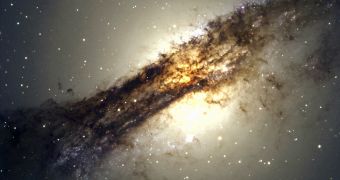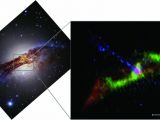Scientists sometimes go wild when naming things, but most of the time they stick to the plain and simple. Case in point, galaxy types.
Spiral galaxies are, well, spirals, elliptical galaxies are elliptical, lenticular galaxies look like a lens. So you can imagine astronomers were quite surprised to find spiral arms inside an elliptical galaxy.
Granted, these spiral arms are quite small and there's only two of them, but it's something no one expected in the old and calm galaxy known to its friends as Centaurus A, Cen A to close friends, or more formally NGC 5128.
The reason no one has seen the spirals so far is that they're hidden behind a cloud of dust. Incidentally, it's this cloud of dust that provides the explanation for their formation, the spiral arms are very likely the result of a collision with another galaxy, sometime in the last 300 million years or so.
Besides creating the two unique features, the collision also compacted existing gas and dust and likely sparked a new wave of star formation in the old galaxy that has long stopped creating new stars.
Astronomers used the Submillimeter Array (SMA) atop the Mauna Kea volcano in Hawaii to peek through the dust and see the spiral arms.

 14 DAY TRIAL //
14 DAY TRIAL // 
